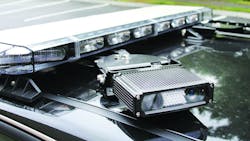The Case for LPR: A Homicide Detective’s Evidence
Nearly 15 years ago, I was named the NYPD’s Commanding Officer for the cold case and homicide squad. When I started, there were 8,000 open homicides dating back to 1970 that had yet to be solved. One of the first things I did was review as many of those files as I could. I read case after case, looked at crime scene photo after crime scene photo. It was a painstaking process. It was also incredibly emotional. People often think of homicide cops as detached from the carnage they see. I can tell you that is rarely the case.
During the course of my career, I attended far too many post-mortem exams. One that still haunts me involved a two-year-old girl – the victim of a stray bullet in the gunfire between warring gangs. I’ve sat across the table from countless families who have begged for justice for their loved ones, and I’ve traveled up and down the east coast looking for fugitives, because justice is what those families deserved.
These investigations require substantial legwork. They require detectives who are relentless in their search for suspects. And they require every tool that is available.
License Plate Recognition technology, or LPR, is one such tool. It is not a smoking gun, or an end-all-be-all clue that alone can land someone behind bars – but it does provide incredibly helpful information within the scope of a much larger investigation. And, in the totality of all the evidence collected in a case, LPR data can be a key element that facilitates the expeditious closure of a violent crime case.
I do not discount anyone’s opinions or concerns when it comes to the issue of privacy. As technology plays a growing role in our everyday lives, questions must be asked. In the case of LPR, however, concerns are often more visceral than they are based in fact.
As we all know from standing in lines at the DMV, everyone who owns a vehicle must have a license plate prominently displayed on the back and – depending on the state – the front of that vehicle. It is not private information – and that has been decided by judges across the country in case after case.
In a decision late last month, U.S. vs. Yang, No. 2:16-CR-231-RFB (D. Nev), Judge Richard Boulware II denied Defendant Yang’s motion to suppress evidence related to license plate detections. Judge Boulware made three significant findings with respect to LPR technology: First, “Yang does not have a reasonable expectation of privacy in the observation (or the location of the observation) of the vehicle he was driving on public streets with other vehicles.” Second, there was no form of ‘electronic trespass’ that might implicate such a reasonable expectation of privacy. Judge Boulware found the detection of the license plate “was not identified by use of any invasive digital technology…” but rather “…obtained through random observation(s) recorded on public streets.” And third, Judge Boulware found “no evidence in this case to suggest that law enforcement officers used the [LPR] database to regularly or continuous monitor the movements of Yang or [the vehicles at issue].”
In U.S. v. Yang, the data collected from the LPR system was used as part of the evidence in a warrant issued that led to the discovery of stolen mail, forged money orders and other illegal items at this suspect’s home. The LPR camera collected only the license plate number – a snapshot of where the vehicle was located at a specific time. The driver was not identified by the system, and the vehicle itself was not tracked. However, the license plate was captured at a location that offered evidence that the vehicle associated was involved in a crime.
A LPR camera might also capture the license plate number of a stolen vehicle, allowing law enforcement to stop and arrest the driver on his or her way to commit an armed burglary. It can also identify the plate number of a vehicle that was at the exact location of a drive-by shooting when it occurred – leading to a key suspect or a key witness.
In the case of the latter example, I can’t help but think of that little girl – and countless other cold cases I read through as a member of the NYPD. I also think of Isadore Pacht, a Holocaust survivor who was shot and killed inside his tailor shop in the Bronx in 1971. His case wasn’t solved until 2005. Should a family ever have to wait 34 years to make peace with a tragedy? Could LPR have helped identify the people responsible for these deaths? I believe the answer is yes; in many cases LPR technology certainly could have provided a valuable lead that allowed investigators to close many cases faster and facilitate justice.
LPR is not some new and nefarious way to track people to and from the grocery store or their homes or their friend’s homes. It serves a very narrow and specific purpose. Its function is to assist in bringing criminals to justice, or even stopping them before they commit further damage. How can law enforcement neglect such a tool? The key to leveraging LPR is transparency and ensuring the public is educated about the tool’s strict policies and adherence to privacy laws. When presented with all of the information, the case for LPR is clear.
At Vigilant Solutions, we take the responsibility of assisting customers who use our license plate recognition technology - or any of our image analytics technology – in the most effective way possible. That means ensuring they are compliant with privacy laws, along with having the means to solve crimes faster and more efficiently. To that end, we recently sent an open letter to our customers emphasizing our full support in their efforts to incorporate LPR into their investigative strategy. Our mission is to provide a solution that assists law enforcement in keeping communities safe across the globe.
Crime is an inevitable burden in any society. Yet, with crime-fighting technologies like LPR, law enforcement officials have a higher probability of generating leads and quickly solving cases. As someone who served in the police force, I remain dedicated to keeping our communities safe and creating awareness of the new solutions available to federal, state and local law enforcement agencies.
Tom Joyce is a retired member of the NYPD in the rank of Lieutenant Commander of Detectives and Vice President of Business Development at Vigilant Solutions. He can be reached at [email protected].
About the Author
Lt. Commander of Detectives Tom Joyce (ret), VP of Business Development for Vigilant Solutions
VP of Business Development for Vigilant Solutions
Tom Joyce is a retired member of the NYPD in the rank of Lieutenant Commander of Detectives. He commanded the NYPD Cold Case Squad upon his retirement and additionally held many other roles within the detective and organized crime bureaus. Tom now serves as Vice President of Business Development for Vigilant Solutions.

